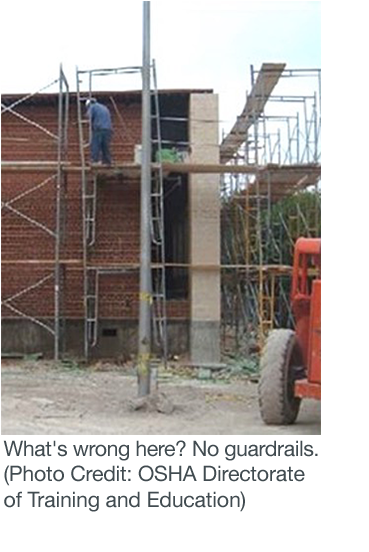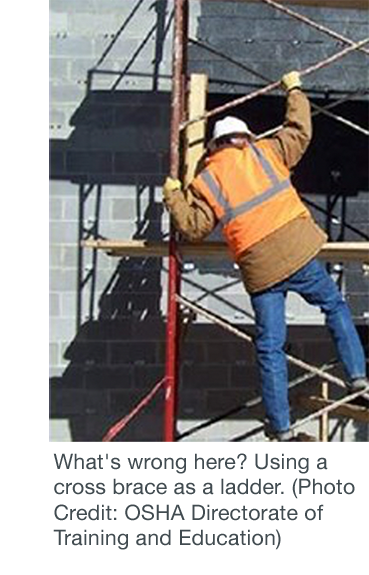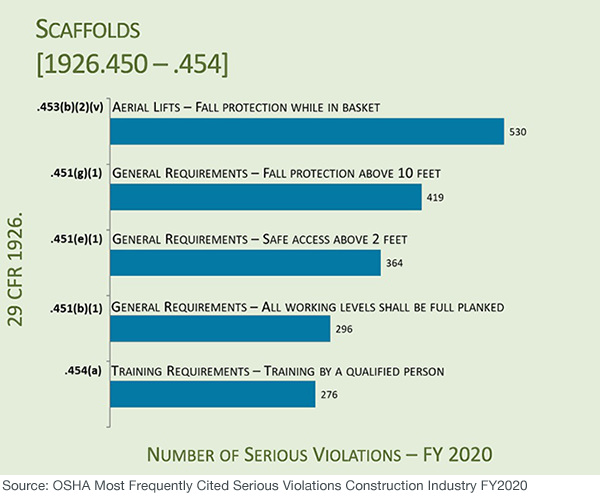OSHA scaffolding regulations are clear, but bad habits can be hard to break.
Falls are the leading cause of death in the construction industry, and according to the Bureau of Labor Statistics, falls from scaffolds made up 18% of them. Scaffolding accidents account for about 4,500 injuries every year according to data from OSHA. In 2018 alone, 46 workers fell to their deaths from scaffolds.
Most injuries can be prevented by following scaffolding safety precautions dictated by OSHA scaffolding regulations, but violations of the rules are common.
Top 5 scaffolding violations in 2020
Companies looking to improve their scaffolding safety would be wise to avoid these five violations, which were the most frequently cited serious scaffold violations in 2020.
1. Use of fall protection while in a basket
OSHA standard 1926.453(b)(2)(v) requires workers to wear a body belt, with a lanyard attached to the boom or basket, when working from an aerial lift, including a scaffold.
2. Use of fall protection above 10 feet
According to OSHA standard 1926.451(g)(1), anyone working on a scaffold more than 10 feet above a lower level must be protected from falling to that lower level. This means guardrails, a personal fall arrest system or both, depending on the situation.
 Guardrails are necessary in many cases. Too often, falls occur because a guardrail wasn’t installed or someone didn’t install it properly. Workers also may take down guardrails temporarily and fail to put them back up.
Guardrails are necessary in many cases. Too often, falls occur because a guardrail wasn’t installed or someone didn’t install it properly. Workers also may take down guardrails temporarily and fail to put them back up.
Workers should pay special attention to anchoring the fall arrest equipment when scaffolding is being erected or dismantled and guardrails aren’t present. The scaffold does not meet the strength requirements for an anchorage point. OSHA stipulates that anchorage points used for fall arrest equipment must support at least 5,000 pounds per attached employee and remain independent of anchorage points used to support or suspend platforms.
 3. Safe access above 2 feet
3. Safe access above 2 feet
Workers may be tempted to climb cross braces to access the scaffolding platform, but standard 451(e)(1) prohibits it.
Instead, if the platform is more than 2 feet above or below the point of access, a ladder, stair tower or other means of access outlined in the standard should be used. Steps and ladders used for climbing from one level to another must have slip-resistant treads and extend at least 3 feet above the platform level.
4. Full planking on all working levels
Every platform on all working levels of a scaffold requires full planking or decking between the front uprights and the guardrail platforms.
Leaving a gap between planking and decking sets up a trip hazard. Workers can eliminate the trip hazard and the chance of receiving a citation by limiting the space between planks and decks to 1 inch or less. The exception is a spot where a wider space is needed, such as around uprights.
5. Training by a qualified person
Standard 126.454(a) requires that anyone working on a scaffold be trained by a qualified person to recognize the hazards associated with that type of scaffold — including falls, electrical hazards and falling object hazards — and understand how to control or minimize them. Training should include scaffold use, material handling and load capacity.
OSHA scaffolding violation statistics 2020

Scaffolding safety tips
Follow these additional scaffolding precautions to stay compliant and help keep employees safe.
Don't overload a scaffold
According to OSHA, scaffolding must be able to support at least four times the maximum intended load, but that doesn’t mean it’s safe to exceed the manufacturer's stated capacity. Contractors should not use a scaffold to store extra tools or material or overload it with too many workers.
Make sure scaffolding footings are on stable, level ground
Don't set up scaffolding so it's resting on frozen, muddy or soft ground. It also shouldn’t rest on concrete blocks or anything else that can shift while employees are on the scaffolding.
Check and re-check the scaffold assembly
Ensure that all wheels and castors are locked, that platforms are fully decked or planked with gaps of no more than 1 inch, that all sections are pinned or secured and that the front face of the scaffolding is no more than 14 inches from the work. In general, all scaffold assembly must be supervised by a competent person.
Secure tall scaffolding
If the scaffolding is four or more times taller than the width of its base, tie the scaffolding off or secure it to the building or another stable structure.
Train all scaffold workers
This bears repeating: OSHA standards on scaffolding require that anyone working on scaffolding be trained about the hazards they might encounter and how to control or minimize them. Training is one of the best way to avoid accidents.
OSHA offers scaffold safety checklists for different types of scaffolds that identify specific hazards and controls.


